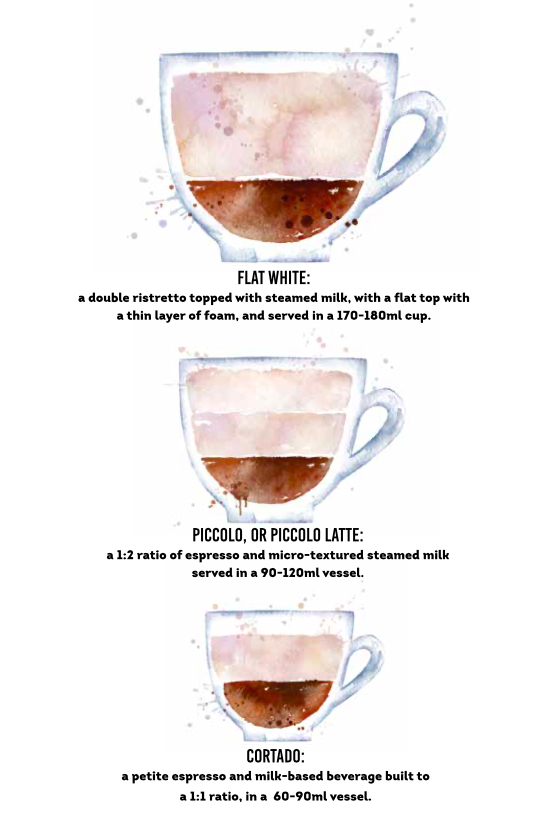What is your favourite order at your local cafe?
Words by Ishan Natalie
The interpretation of what is a Cortado, Piccolo and Flat White is as controversial and contentious a topic as ‘what is speciality coffee’. Everyone has their own opinion and version of what they think it is and we often see inconsistencies across cafes in the way they are made and served. So, what are these beverages really?

Let’s start with the Cortado. Originating in Spain, this refers to the dilution of coffee with milk. The most common term is ‘espresso cut with milk’. A Cortado is a petite espresso and milk-based beverage built to a 1:1 ratio of espresso and micro-textured steamed milk; usually made in a 60-90ml vessel. The ratio of milk is merely enough to reduce the acidity of the espresso. You may ask “but is that not the same as an Espresso Macchiato?”. Nope! A Macchiato, by definition of the Italian word, means espresso ‘stained' with milk and traditionally the foam is scooped on to the espresso as opposed to a Cortado which is poured and has very little, if any, foam for a milkier experience.
Compared to a Cortado, the Piccolo, or Piccolo Latte, is a 1:2 ratio of espresso and micro-textured steamed milk served in a 90-120ml vessel. The slightly, milkier beverage, softens the espresso more, creating a harmony in flavour, strength and mouthfeel between espresso and micro-textured steamed milk. It is a lot gentler on the palate than that of a Cortado, or Espresso Macchiato. These aren’t that common in South Africa, but the Gloria Jeans franchise which originated in Australia makes them true to the Aussie style!
But my favourite by far, and for most consumers, is the Flat White. Born in Australia or New Zealand (depends who you ask!), it is a double espresso (for purists, these are pulled as ristrettos), topped with micro-textured steamed milk, with a flat top with a thin layer of foam, and served in a 170-180ml cup. It is the epitome of balance and luxury between espresso and micro-textured steamed milk. A Flat White also allows the barista opportunity to pour more intricate Latte Art as opposed to the Cortado and Piccolo. As with any terminology, it varies across cafes, so at your local Seattle, if you wanted a flat white, you’d ask for a Double Short Latte.

A beautiful flat white from Simple Bru Coffee in Melkbos
What makes these beverages so delicious is perfect execution of espresso and micro texturing and steam in milk. Based on the roast profile and origin of the coffee, recipes may vary but milk is a lot simpler. High fat, full cream milk works best as the fat provides higher sweetness and richness to the beverage. To further enhance this and the mouthfeel, baristas need to soft stretch the milk whilst cold (soft, intermittent hissing sounds) and then texture and steam the milk gently until it reached 55 – 65 degrees Celsius. With the steaming pitcher tilted at around 30 degrees angle, simply soft stretch in the beginning to create microfine bubbles for micro-textured foam, and then, when the milk is at room temperature, slide the pitcher up the steam wand, submerging the steam wand tip about 2-3 cm below the surface of the milk, maintain a constant swirling of the milk, shutting off the heat when you reach the desired temperature above. This ultra-velvety, sweet and dense milk, makes all the difference in these beverages.
For the novice/ home barista, getting micro-textured milk takes time and lots of practice – it’s often trial and error, familiarity and routine. But practicing steaming of milk is very expensive, so here are a few tips to reduce your practice costs:
An interesting thing happened a few months back in the industry. All over the country a particular and well regarded brand of milk was posing a problem for baristas. It just wouldn’t foam! So it still tasted good, but latte art was a no-go! Foam quality comes down to a few factors: cattle feed/ diet, seasons and processing. The best quality milk is usually in the warmer months, especially with free roaming cows. Free roaming cows and many cattle herds, graze in paddocks or vast spaces with healthy and thriving grass from the summer conditions. This is their most natural feed and produces the highest quality milk. In the colder months however, the grass quality deteriorates which changes the way in which the cow digests it, and ultimately changes the milk it produces. And sometimes, the natural diet is supplemented with feed that is manufactured. To dairy farmers, the priority is meeting the standard requirements for use and sale. And for most applications of that milk, no change can be detected, but the micro texturing of milk in cafes exposes the minute details, as the industry experienced when the milk just would not foam. Often, these changes show in the form of bubbles throughout the surface of the espresso-based milk beverages, often less sweet and reduced mouthfeel. Another challenge is over dilution of milk – milk that has too much water, dilutes the proteins and fats, which when steamed, creates large soapy bubbles that to not bind to maintain foam structure, and completely disintegrate, leaving you with plain hot milk and no foam. This could be a processing issue, or an issue in the cold chain where that particular milk may have frozen at some point (below zero degrees Celsius).
Understanding milk and how to troubleshoot is often neglected but as important as understanding coffee and the extraction parameters for quality. Espresso beverages made with milk form part of around 90% of what customers order and consume, milk makes up on average 85% of that beverage. So it’s important to take the time to understand milk background and properties, and to find the best quality milk for you.